Final report for FNE22-024
Project Information
We sought to provide a working example of crops that can be effectively intercropped within rows of trees to provide an economic return while the trees are establishing, as well as make more effective use of the resources needed to grow the trees.
We planted 128 fruit and nut trees (Asian pear, American persimmon, and Chinese chestnut) in rows with 11 different annual and perennial crops planted within the tree rows. We tracked inputs, labor, and harvest data on those crops, and made general observations about suitability for those crops in an intercropping system. Perennial crops that had no yield in the first 2 years do not have harvest data, but can still be important and useful crops to consider.
We hope that the accompanying video provides inspiration and ideas for people considering adopting this practice. The crops that we chose to trial didn't satisfy all of our desired qualities each, but our primary considerations for crop selection were:
- Crops that are high value
- Crops that are difficult to mechanize. Crops that can easily be mechanized, planted and cultivated with machines make more sense to grow at field scale.
- Crops that thrive at wide spacing.
- Crops that are perennial, especially those that can begin to yield relatively quickly.
- Crops that can produce in partial shade when the trees are mature.
- Crops that you have a market for!
One of our primary goals was to showcase a method to create a marketable economic yield immediately and into the future in the same space that tree crops are planted. Through this project, we demonstrated some good working examples (some of our favorites were rhubarb, peppers, and pink currants) of how you might create those economic yields through intercropping. We also shared some helpful considerations for crop selection, and a system of weed control using landscape fabric that helps make intercropping easier to put into practice.
Another goal was to show how growing tree crops can be more accessible by making more efficient use of the resources necessary to grow trees. In this project, we tried to show how many of the resources used to grow trees can have some overlap with growing other crops in the same row, thereby making the whole system more profitable and increasing the overall yield from the same space.
This project seeks to:
- Identify annual and perennial crops that can effectively be intercropped between trees and provide the best combination of high economic return and low amount of time planting, tending, harvesting.
- Provide a working example of intercropping in action so that other farms that want to adopt this practice can learn from our work. We hope seeing a successful agroforestry installation will inspire other farmers to adopt these practices and in turn improve their businesses and the ecosystems that their farms are a part of. We will engage with the public through our social media following, an on-farm field day, and a short video detailing the project.
There are numerous benefits to incorporating tree crops into agricultural systems (agroforestry) through intercropping. Intercropping is the practice of planting other crops in between rows of trees in the same row. This is different from alley cropping, where crops are grown in the "alleys" between rows of trees. Some of these benefits include sequestering carbon, reducing erosion, lessening wind speeds to reduce evapotranspiration, and increasing the water holding capacity of the soil. Others are diversifying farm income streams, increasing the climate resiliency of farms, increasing biodiversity of farm ecosystems, and boosting the overall productivity of a given area. (Gold, 2009, Schoeneberger, 2017) We chose to focus on intercropping in this study because rows of trees can be planted closer together in more of an orchard type installation, whereas alley cropping requires more space between each row of trees. We also wanted to take advantage of and utilize the space in row between each tree because it is already being irrigated and kept weed free.
Despite all of these benefits, the agroforestry practices of intercropping and alley cropping are not very widely adapted in the northeastern US. In fact, there are very few examples I have been able to find on actual working farms. Aside from secure land tenure, the biggest hurdles to establishing agroforestry systems are the length of time before a crop can be harvested, the cost of establishment, and lack of demonstration sites and technical assistance for these practices.
This proposed project would address some of these challenges by identifying crops that would provide an economic yield immediately the first season while utilizing the same space designated for the tree crops. Some of the perennial crops we want to trial would also continue to provide a yearly return growing alongside the trees as the trees begin to bear fruit. This technique would boost the overall productivity of the installation, while simultaneously providing earlier yields/income as the trees are establishing. My hope would be that, by removing some of the barriers to establishing tree crops, more farms would be encouraged to plant trees and diversify their farming operation.
Cooperators
- - Technical Advisor (Educator)
Research
We planted 128 fruit and nut trees in the spring of 2022 (Asian Pears, American persimmons, Chinese chestnuts). We prepared the site by subsoiling, chisel plowing, and rototilling planting strips every 20 feet on center in the planting area. We planted the bare root trees at their required spacing, and installed 3 foot wide strips of landscape fabric mulch on either side of each row of trees, and drip irrigation in the row. In the irrigated section of soil in between the 2 strips of landscape fabric, and between each tree, we planted trials of 11 different annual and perennial crops at their required spacings and planting timing. The trial crops were rhubarb, basil, winter squash, pepper, various medicinal herbs, flowers, nursery trees and shrubs, strawberry, pink currant, aronia, and juneberry. Plant material was either purchased (rhubarb, strawberry, aronia and pink currant) or propagated from seed in the Whistle Down Farm greenhouse (basil, winter squash, pepper, flowers, medicinal herbs, nursery trees, juneberry).
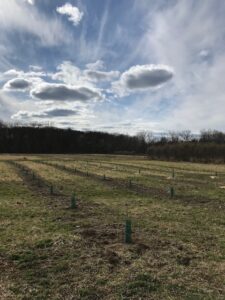
We tended the trees by weeding, irrigating, fertilizing, and mowing alleys between trees as needed. Throughout the course of the project, we kept the intercrop plantings weeded and mulched as needed. We harvested the interplanted crops as they were ready. We kept track of labor and other inputs in time and dollar amount in an excel spreadsheet, and also documented the yield in pounds and dollar value of each crop as it was harvested.
SARE-grant-crop-data spreadsheet
We also documented all processes (site prep, planting, different stages of crop growth, harvest, etc) in photo and video.
In August of 2022 we hosted a field day for other farmers and interested parties to visit the site and see a working example of an intercropping system.
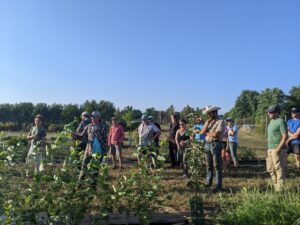
At the conclusion of the project we produced a short video documenting everything we did and some of our observations.
General thoughts:
We liked this system and the plants did well. The trees benefitted from extra attention because we were regularly returning to check on/tend/harvest the intercrops, so we also gave extra care to the trees. The overall weed suppression of this system was really good, especially when compared to other plantings of trees that we have done on the farm. The Asian Pears have a fairly sizable marketable crop on them in the third year after planting. The first nut burrs are present on a couple of Chinese Chestnuts, and there is one American persimmon that fruited this year.
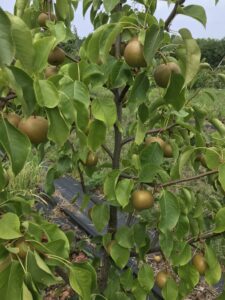

If we were doing this again, we would plan to just plant annuals in the first year at the same time as we were planting the trees while the ground was freshly prepared with the tractor, and then transition over to perennials for subsequent growing seasons. In the several years since we first planted, we have transitioned most of the spots that were originally in annual crops over to rhubarb, and to perennial herbs and flowers for beneficial insect habitat (a non marketable, but also important yield!)
Our main challenges were:
Re-preparing planting areas after an annual intercrop was done and we wanted to plant something else. This was a challenge because there isn't a great way to use machines to get into the strip between the landscape fabric mulch, so it had to be done using hand tools (broad fork, stirrup hoe, rake). Because of the tedious/inefficient nature of this work, over the course of the project when annual crops were done, we switched over to perennial crops that we could just leave in and add cardboard and wood chip mulch yearly to suppress weeds.
Voles were definitely present and something to be aware of. The landscape fabric mulch provides good habitat for them. However, we didn't have any damage to the trees as they were individually protected with vole guards (and perhaps the tree species we planted were less desirable?). When we direct seeded winter squash in the first year, they ate all the seeds and we had to replant with transplants.
Crop specific notes:
Basil. We had the nicest basil crop that we've had in years, which we attribute in part to being planted in a single row and improving airflow. Downy mildew often destroys our basil before it even gets to marketable size. We got multiple good harvests off our intercropped planting.
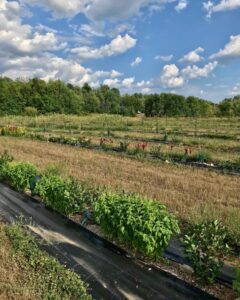
Flowers. Adds beauty to the system. We don't have much of a market for cut flowers, but if you do this could be a good crop to consider, especially for flowers that need more space like dahlias.
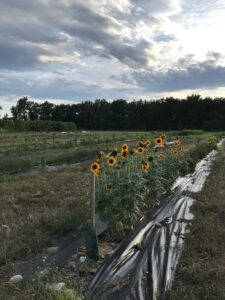
Winter Squash. Despite the squash thriving, we probably would not plant winter squash again in this system. Winter squash is fairly easy for us to mechanize and grow at large scale efficiently. It could still be a good fit for a smaller scale farm, particularly higher value specialty varieties. We put down rolled cardboard in the landscape fabric seam and planted through that-weed suppression was excellent with no supplemental hand weeding.
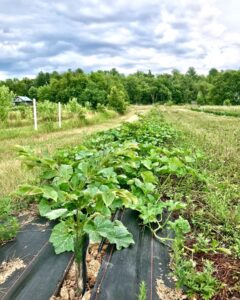
Peppers. This can be a challenge for us to grow on bare ground, because when the plants get tall it is hard to drive over the top of them with cultivation equipment, and the fruits are easily damaged. They did great with the excellent weed suppression of the cardboard/landscape fabric combination, and being on drip irrigation helped with blossom end rot.
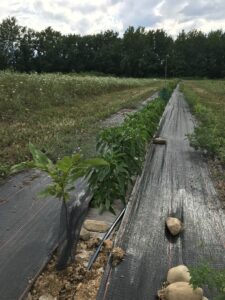
Medicinal Herbs. We trialed several different herbs-skullcap, tulsi, lemongrass, chamomile, blue vervain. Tulsi and lemongrass were standouts because they grew very vigorously and quickly filled out the space to smother weed competition. Blue vervain is great because it is a perennial and native pollinator plant, so we have left some patches in to naturalize and provide us with a non marketable, but still important, benefit.
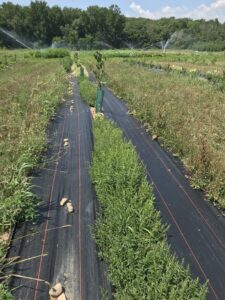
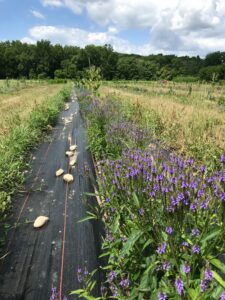
Tree Nursery. One of the enterprises on our farm is a tree nursery, so we were excited to try some of our nursery crops in this system. We planted direct seeded chestnuts, and willows, elderberries, currants, and hybrid poplars from cuttings. The cuttings were especially effective because we stuck them through cardboard and weed control was excellent. Everything did great. We decided to only plant nursery crops for one season though because we didn't want to damage the permanent trees in subsequent years when their root systems are bigger when we were digging the nursery trees up for sale. Alternatively, you could shrink the area that you are using to grow the nursery crops to give the permanent tree's root systems more space as they grow. If you have a market for nursery crops, especially cuttings, this would be a good one to think about.
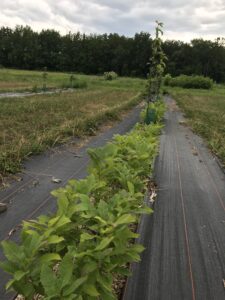
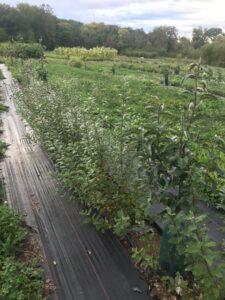
Strawberries. We had a very hard late frost in May of the first fruiting year of the strawberries, and completely lost the crop. Being in smaller, approximately 12' blocks, made it harder to apply frost covers so we skipped it. Our field scale production of strawberries is easier to efficiently cover with big frost covers. It also is more challenging to renovate the strawberries when compared with field scale production because we use machines for this. So, while it is fun to have the strawberries, they are not something we would do again. It might be a good fit for a very small scale farm.
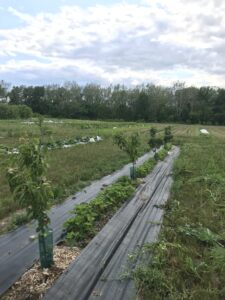
Rhubarb. This was probably our favorite crop. When we are not intercropping rhubarb, we grow it in basically the same way, between strips of landscape fabric with drip irrigation. So it is great to be able to use that same method to occupy the understory of a row of trees. We think in future years it will also benefit from being in partial shade because rhubarb prefers cooler temperatures.
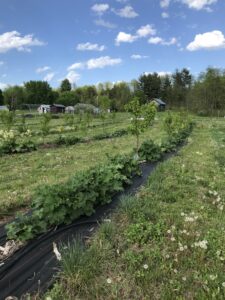
Aronia/Pink Currant/Juneberry. We are lumping these 3 together because their growth habits and management within this system are very similar. While we didn't get a marketable yield in the time period of this project in which we were collecting harvest data, they are all loaded with fruit in the third year of production. They are pretty easy to manage the weeds by mulching, and should be able to continue to produce in partial shade. One note is that juneberries are susceptible to cedar apple rust, and we did have some damage/reduced yield due to that.
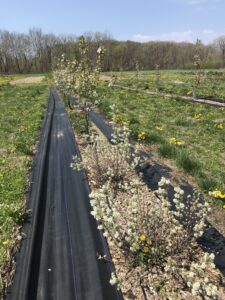
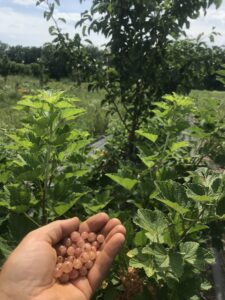
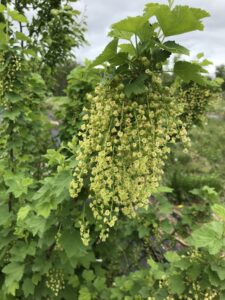
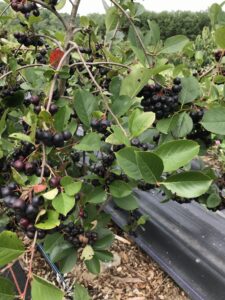
One of our primary goals was to showcase a method to create a marketable economic yield immediately and into the future in the same space that tree crops are planted. Through this project, we demonstrated some good working examples (some of our favorites were rhubarb, peppers, and pink currants) of how you might create those economic yields through intercropping. We also shared some helpful considerations for crop selection, and a system of weed control using landscape fabric that helps make intercropping easier to put into practice.
Another goal was to show how growing tree crops can be more accessible by making more efficient use of the resources necessary to grow trees. In this project, we tried to show how many of the resources used to grow trees can have some overlap with growing other crops in the same row, thereby making the whole system more profitable and increasing the overall yield from the same space.
In our future tree plantings at Whistle Down Farm, we plan to use intercropping to boost their productivity and efficiency, and hope that other growers will consider adopting this practice as well.
Education & Outreach Activities and Participation Summary
Participation Summary:
We hosted a field day on August 29, 2022 showcasing the trials we had done to date. There were 31 people in attendance.
Throughout the project, we have posted photos and short video clips to our social media. A conservative estimate is 1500 views from our 4,500 followers.
We produced a video detailing the highlights of our project. https://youtu.be/CpiS15SqqhM
The video was completed at the end of the project. Now that we have the video, available on YouTube, we will continue directing people to view it after the conclusion of the project.
Learning Outcomes
So far I have gained a better understanding of what crops do better and are more viable in this system, as well as some of the challenges and benefits of growing in this system.
Project Outcomes
This project has allowed us to identify what crops are a good fit for our farm, and some ideas for other farms to consider, for intercropping with trees.
We feel good about how this project went. We identified crops that worked well for us in an intercropping system, and some that were less of a good fit (see individual crop descriptions). We also think that the ability for people to see examples of intercropping in practice has a lot of value, and we documented our work in phot and video form.
In our future tree planting, we will continue to use intercropping. We feel that the increased yield from the space where the trees are planted, and the improved growth of the trees are good motivating factors.
We think that anyone who is thinking about planting trees might want to consider this practice, especially small scale farms that need to ensure a yield from all of their acres at all times.